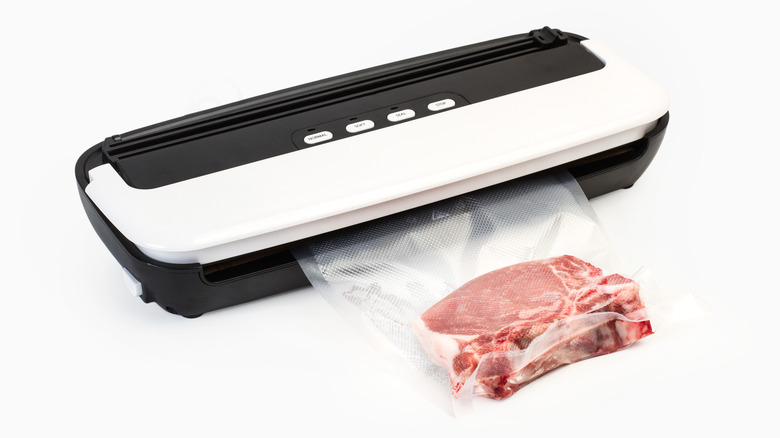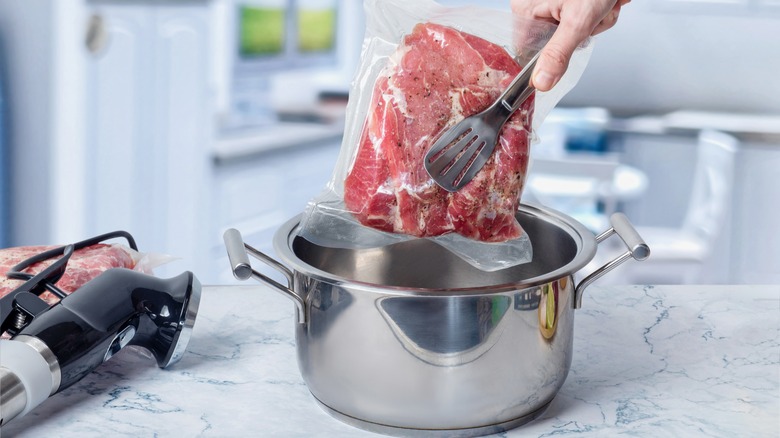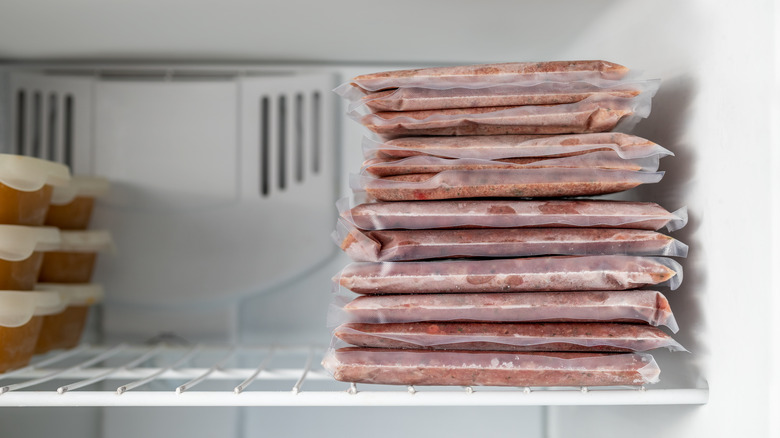Why Every Home Cook Should Own A Vacuum Sealer
If you're a fan of thrift store shopping, you've likely stumbled across older versions of vacuum sealers, a popular culinary gadget in the '60s. The ones now marching into home kitchens across the globe are decidedly more nuanced, some with extra tech touches and adapters for broadened use. But they're still an efficient way to remove air from food-filled pouches or containers, preserving what's tucked inside.
With walloping budgets for almost every consumer, the last thing anyone wants is food waste in their home. That's where a vacuum sealer makes a lot of sense in the modern kitchen, acting as an agent of food preservation and reducing the monthly grocery budget.
We all love leftovers, but vacuum sealing goes well beyond those lingering bits of Sunday supper or bagged take-home morsels from local restaurants. Here's a fresh look at how that relatively affordable countertop air sucker can come in handy — after all, there's a reason it's survived and thrived for decades in commercial and home kitchens.
Vacuum sealing can extend the life of your fresh, frozen, wet, and dry foods
An obvious reason for owning a vacuum sealer is to cook food the "sous vide" way. With a little practice and the right equipment, including a vacuum sealer, you can perform that temperature-controlled, water-bath method of cooking at home. But let's face it: The average kitchen and its chef aren't embracing sous vide on a regular basis.
Much more practical uses for a vacuum sealer, in addition to saving leftovers, include extending the refrigerator shelf life of fresh vegetables, fruits, cheeses, and meats. Vacuum sealing essentially removes air and discourages the growth of food bacteria, reducing the likelihood of having to toss out excess from your grocery-store run, such as those bunches of fresh basil, parsley, or cilantro for recipes only requiring a sprig or sprinkle.
Farm-stand goodies and overflowing bounty from seasonal home gardens all get a freshness boost from vacuum sealing. It also facilitates buying in bulk at big-box stores or wholesalers and makes it easier to preserve meat from game hunting.
Then there are dry goods and kitchen staples. You can seal in the flavors and freshness of coffee beans, noodles, spices, and pretty much any dry ingredient with expiration dates. Hello, bags of crispy chips and snacks — just reseal the openings to keep that crunchy goodness from going stale. When freezing vacuum-sealed foods for an even longer life, the thickness and resilience of the bags lessen the risk of moisture loss and protect against freezer burn.
Vacuum sealing attachments and settings go beyond the basics
Depending on your chosen model, today's vacuum sealers range from simple "press and heat" versions to ones with digital settings and selectable sealing modes. Some offer a "pulse" mode for protecting delicate items like baked goods and a "marinate" setting for conveniently sealing bags in liquids without removing the air.
Jess Pryles, the creator of Hardcore Carnivore seasonings, explains that marinating meats with a vacuum sealer potentially cuts the marination time from 24 hours to about 30 minutes (via YouTube). Removing air from the bag creates a low-pressure system that pushes the marinade directly into the meat, eliminating the need for piercing it as with traditional methods.
Attachments make a vacuum sealer even more versatile, allowing the removal of air from more heavily structured containers than the usual plastic pouches. A bottle stopper attachment pulls air from a bottle of wine, prolonging its expiration, while jar accessories reseal a glass jar, providing an easy way to store and access ingredients without using new plastic every time. You can even find handheld versions for more flexibility and expanded use.


